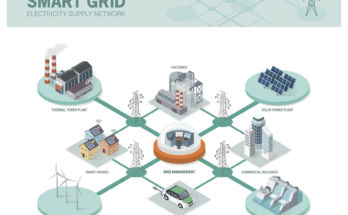
The inevitable rise of solar power is on the brink of a revolution. The world is on the cusp of a significant transformation in the way we generate energy. Recent research suggests that we may have already crossed a crucial “tipping point,” with solar power poised to become our predominant energy source. This groundbreaking study, founded on a data-driven analysis of technology and economics, indicates that solar photovoltaics (PV) will likely take center stage before 2050, even without substantial support from aggressive climate policies.
However, while the future seems bright for solar energy, there are four potential obstacles that could hinder this transition: the development of stable power grids, financing solar projects in developing economies, ensuring the capacity of supply chains, and addressing political resistance in regions where job displacement is a concern.

The Transformative Power of the Inevitable Rise of Solar Power
The inevitable rise of solar power is on the brink of a revolution. A combination of factors has reshaped the energy landscape, driving the ascension of solar energy to dominance. Dr. Femke Nijsse from the University of Exeter’s Global Systems Institute notes, “The recent progress of renewables means that fossil fuel-dominated projections are no longer realistic.” In essence, we have veered away from the ‘business as usual’ scenario that once dictated the power sector.
A more holistic understanding of how innovation and economic growth are intertwined has attributed to this shift. Rather than considering innovation as an isolated occurrence, it is now evident that a virtuous cycle exists, where technological deployment and cost reduction continually feed into each other. This perspective has allowed us to account for the rapid growth of solar technology over the past decade and project it into the future.
The Inevitable Rise of Solar Power is on the Brink of a Revolution
The inevitable rise of solar panels is on the brink of a revolution. By integrating models that account for positive feedback mechanisms, we can confidently project that solar PV will dominate the global energy mix by the middle of this century. However, there are critical considerations to keep in mind.
Overcoming the Barriers
Instead of solely focusing on implementing a solar transition, governments must concentrate their efforts on addressing the four key barriers that stand in the way of this inevitable shift:
1. Grid Resilience
Solar power generation is inherently variable due to factors like day-night cycles, seasonal changes, and weather conditions. To ensure a seamless transition to solar energy, power grids need to be designed to accommodate this variability. Dr. Nijsse says we need to manage variability to avoid fossil fuels. We can invest in wind energy, improve transmission networks, use electricity storage, and create demand-regulating policies like charging electric vehicles during non-peak hours.
2. Access to Finance for the Inevitable Rise of Solar Power
The growth of solar power hinges on the availability of financial resources. Currently, low-carbon finance predominantly resides in high-income countries. The inevitable rise of solar panels is on the brink of a revolution. International funding tends to favor middle-income nations, leaving lower-income countries, particularly in Africa, struggling to secure adequate solar finance, despite their vast potential for investment. Ensuring equitable access to finance is essential for the widespread adoption of solar energy.
3. Supply Chains
A metal- and mineral-intensive future is poised to power by solar energy. The demand for “critical minerals” will significantly rise. Raw materials like lithium and copper heavily support electrification and batteries. As countries accelerate their decarbonization efforts, these materials will contribute significantly to the demand for renewable technologies. By 2040, a substantial share of total mineral demand for copper, rare earth elements, nickel, cobalt, and lithium is projected to be accounted for by renewable technologies. Ensuring the success of the solar revolution is vital by maintaining a stable supply chain for these critical resources.
4. Political Opposition Against The Inevitable Rise of Solar Power
Resistance from declining industries can pose a significant challenge to the transition to solar energy. The speed at which this transition unfolds depends not only on economic decisions by entrepreneurs but also on policymakers’ support. The inevitable rise of solar panels is on the brink of a revolution. A rapid shift to solar power may jeopardize the livelihoods of up to 13 million individuals worldwide employed in fossil fuel-related industries. Regional economic and industrial development policies can help address this inequity and mitigate the risks associated with resistance from these declining industries.
In conclusion, the future of energy appears to be inexorably tied to solar power. The sun’s abundant and renewable energy holds the key to a more sustainable and resilient global energy system. The inevitable rise of solar power is on the brink of a revolution. However, the path to a solar-dominated world is not without its challenges. By actively addressing the four crucial barriers—grid resilience, access to finance, supply chain stability, and political opposition—we can pave the way for a brighter, more sustainable future powered by the sun.
Reference
https://www.sciencedaily.com/releases/2023/10/231017123409.htm


